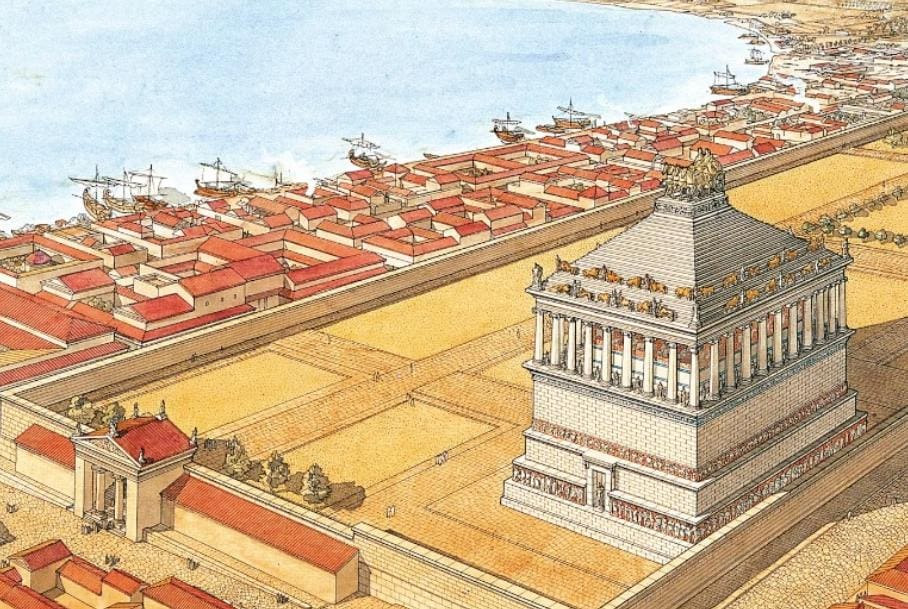The Mausoleum of Halicarnassus, one of the most magnificent structures of antiquity, was originally built as a mausoleum.
The Pyramid of Cheops, the Hanging Gardens of Babylon, the Statue of Zeus, the Temple of Artemis, the Colossus of Rhodes and the Lighthouse of Alexandria… Yes, these are the seven wonders of antiquity. However, our attentive readers may have noticed that the list is incomplete! Let us state right away that the missing piece is the Mausoleum of Halicarnassus, which is also the subject of this article. The Mausoleum of Halicarnassus, built a long time ago in the borders of Bodrum district of Muğla, in the Anatolian geography where we live today, continues to be one of the most famous and most magnificent mausoleums in history. Even though it was destroyed centuries ago! Here is what you need to know about the Mausoleum of Halicarnassus, one of the seven wonders of antiquity.
As you know, Anatolia has been the habitat of important civilizations throughout history
Ionians, Lydians and Phrygians, Greeks, Persians… The list could go on. But there is no need to beat around the bush. This has led to the emergence of unique structures, historical artifacts and cultural treasures belonging to different civilizations in the geography we live on today. It is not for nothing that Anatolia is almost like an open-air museum. In fact, two of the seven wonders of antiquity were built within the borders of our country: The Temple of Artemis in Ephesus and the Mausoleum of Halicarnassus in Bodrum. Let’s take a closer look at this most famous mausoleum in history.
The Mausoleum of Halicarnassus, one of the Seven Wonders of the World, was built between 353 and 350 BC

This magnificent structure was a mausoleum built for King Mausolus, the ruler of the ancient settlement of Halicarnassus (Halicarnassos).
Mausolus, who ruled in the ancient city between 377-353 BC, was basically a prince under the Persian ruler. However, he was the absolute ruler of the region under his rule. Perhaps for this reason, he was referred to as a king, not a prince.
During his reign, Mausolus succeeded in making Halicarnassus one of the most important settlements of the region
A modern wall for the city’s defense, temples, a harbor and a large palace were among the structures built by Mausolus. However, the city’s most magnificent structure was not to be revealed until after Mausolus’ death.
The Mausoleum of Halicarnassus was built by Artemisia, wife (and sister) of Mausolus

Artemisia II wanted a magnificent mausoleum to be built in memory of King Mausolus. But she had other demands about the tomb. She wanted the tomb to reflect the greatness of the late king and his hopes for the afterlife. This would turn the mausoleum into one of the most important human structures in history.
The architectural concepts of Greek, Eastern and Egyptian civilizations were adopted in the construction of the Mausoleum of Halicarnassus
For example, at the top of the 55-meter-high, 24-step pyramid was a statue of Mausolus leading a four-horse chariot. There was also a 25-meter statue of Artemisia II, and the massive foundation of the structure was decorated with more than 400 statues of people, animals and chariots. The tomb was surrounded by 36 columns.
Artemisia II died around 350 BC. But the mausoleum she had built was not yet complete

Nevertheless, Artemisia’s body was also placed in this tomb.
The Mausoleum of Halicarnassus, built as a mausoleum, was so magnificent that in ancient times it was considered one of the Seven Wonders of the World
It goes without saying that the structure is one of the most famous mausoleums in history, perhaps the first. So much so that even the term mausoleum, which is used for mausoleums, was derived from the name of King Mausolus. In other words, it can be said that the Mausoleum of Halicarnassus, sometimes referred to as the Tomb of Mausolus, gave its name to all the mausoleums built after it.
The invasion of the city of Halicarnassus by Alexander the Great in 334 BC marked the beginning of the end for the mausoleum
Severely damaged during the siege, it was restored in different periods but never regained its former splendor. Earthquakes in the 11th and 15th centuries caused the mausoleum to be largely destroyed. Also in the 15th century, the Knights of St. John used parts of the mausoleum to build St. Peter’s Castle near Bodrum. Thus, the surviving elements of the structure were also severely damaged.
The remains of the mausoleum were only uncovered in the 19th century

British archaeologist Charles Newton noticed the remains of the mausoleum and began excavating the site.
